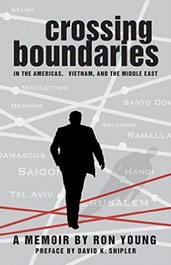Crossing Boundaries in the Americas, Vietnam, and the Middle East: A Memoir
Reviewed by Max L. Carter
August 1, 2015
 By Ron Young. Resource Publications, 2014. 299 pages. $35/paperback; $9.99/eBook.
By Ron Young. Resource Publications, 2014. 299 pages. $35/paperback; $9.99/eBook.
Buy on FJ Amazon Store
I finished Ron Young’s Crossing Boundaries in the Americas, Vietnam, and the Middle East during the fiftieth anniversary of the march in Selma, Ala., the release of the Department of Justice’s critique of police work in Ferguson, Mo., and the Israeli elections that returned Benjamin Netanyahu to power. It was a reminder that so many of the issues to which this inveterate worker for peace and justice has dedicated his life remain powerfully current.
Part memoir and even more a “You Were There” travelogue through scenery that baby boomers in particular will find familiar, this book offers important insight into spiritual and intellectual formation, the lives of history makers, and strategies for effective peace and justice work.
Beginning with a description of an upbringing that those who grew up in the ’50s and ’60s will relate to, Young takes his readers on a journey through a college career at Wesleyan University interrupted by field work for civil rights in the South, peace education activity with the Fellowship of Reconciliation and the American Friends Service Committee, and finally interreligious work around Middle East issues. Along the way, we meet Martin Luther King Jr., Bayard Rustin, Norman Thomas, Dorothy Day, Oscar Romero, A.J. Muste, Hannah Ahrendt, Thich Nhat Hanh, and a who’s who of Quaker activists and figures central to all that has happened in the Middle East over the past several decades.
Besides the interesting insight into many of these figures, Young’s commentary on strategies in organizing for peace and justice underscores how important careful planning is in achieving even the limited success of his and others’ efforts. Careful critique of tendencies in U.S. foreign policy and analysis of the difficulties in negotiations between Israelis and Palestinians give further evidence of just how hard the work of “crossing boundaries” is.
While the first half of the book reflects on historical issues in civil rights, Central America, and Vietnam, the second half offers a continuing review of the ever-vexing situation in Israel–Palestine. Young has worked in this region long enough to see patterns emerge, observe fundamental shifts in individuals’ perspectives, and recognize the trauma-induced intransigence of so many of the stakeholders.
Young recognizes that “It is very difficult simultaneously to hold on to both Palestinian and Israeli narratives; but . . . effective work for peace requires that we do just that.” And it is precisely in this area where some may find fault with his “takeaways” from this work. Understandably sensitive to both “sides,” Young is cautious about the Boycott, Divestment, Sanctions movement and advocacy for a “one-state solution” in Israel–Palestine. His concerns are legitimate, but at the same time, they display a problem with seeking “equity” in a profoundly asymmetrical situation.
Knowing so many of the “players” in the drama Young so vividly writes about, I found his book compelling. Those who are not so intimately involved in the same stories, though, will also find it a good read.
1 thought on “Crossing Boundaries in the Americas, Vietnam, and the Middle East: A Memoir”
Leave a Reply
Comments on Friendsjournal.org may be used in the Forum of the print magazine and may be edited for length and clarity.



I enjoyed Ron’s memoir too, and Max you have described this book well. It’s a great resource for class discussion and groups interested in how one puts faith into action. Friends often advise the practice of answering to that of God in everyone, and that practice depends on a discipline of listening. Ron has honed listening first for that of God and then answering with humility.